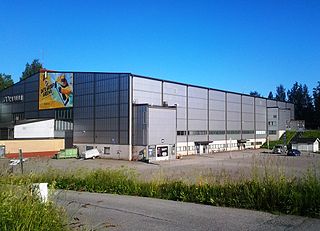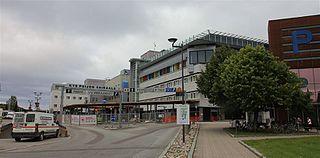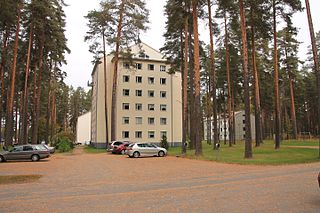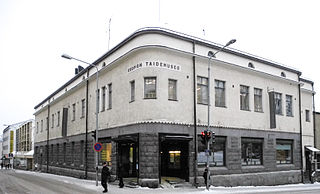
Kuopio is a Finnish city and municipality located in the region of Northern Savonia (Pohjois-Savo). It has a population of 120,248, which makes it the 8th most populous city in Finland and the most populous city in Eastern Finland Province. At the end of 2018, the population of the city center of Kuopio was 89,307. Kuopio has a total area of 4,326.35 square kilometres (1,670.41 sq mi), of which 719.85 km2 (277.94 sq mi) is water and half is forest. Though the city's population is a spread-out 75/km2 (190/sq mi), the city's urban areas are populated comparably densely, making Kuopio Finland's second-most densely populated city. With the city of Joensuu, Kuopio is one of major urbans, economic, and cultural hubs for Eastern Finland.

Kuopio Ice Hall or Data Group Areena, is the ice hockey arena in Kuopio, Finland which is also the home arena of KalPa.
Savonia University of Applied Sciences is a local municipality-owned Finnish institution of higher education based in the cities of Kuopio, Iisalmi and Varkaus.
Kuopio Senior High School of Music and Dance was a specialized high school for music and dance which was founded in 1968. The dance curriculum was started in 1983. The high school was the first specialized senior high of Finnish high schools, which specialized in music and dance. The school gained the name Kuopion yhteiskoulun musiikkilukio in 1995. In 2015, the high school merged with Minna Canth Senior High School to form Kuopio Senior High School of Arts (Lumit).
The Kuopio Province was a province of Finland from 1831 to 1997. The province was named after its capital, city of Kuopio.

Haapaniemi is a district in the city of Kuopio, Finland. It is located south of downtown, about a mile from the market square. The district has a population of about 4,000. The northern end of Saaristokatu, which runs to the archipelago city, leads to Haapaniemi, as does the southern ramp leading to the center of the motorway.

Väinölänniemi is a district in the city of Kuopio, Finland. It is more commonly known for the Väinölänniemi Peninsula, located in this district and surrounded by Kallavesi, with its beaches, sports fields and park areas.

Puijonlaakso is a district in the city of Kuopio, Finland. As the name implies, it is located right next to Puijo Hill and is a very green area. The area has about 6,400 inhabitants, many of whom are students.

Männistö is a district in the city of Kuopio, Finland It is part of the Itkonniemi–Männistö–Linnanpelto division area, which has a population of just over 5,800.

Niuva is a district in the western part of the city of Kuopio, Finland. It is well known as the historic Niuvanniemi mental hospital. In terms of land use, Niuva is mainly a field area around the hospital. The district has few settlements and services, located mainly in the hospital area. However, there is a Länsi-Puijo kindergarten along Suurmäentie. There is a beach on the shore of Lake Kallavesi, just south of the Niuva district in Puijonlaakso.

Julkula is a district in the northwest part of the city of Kuopio, Finland. It is located 4-6 km from the city center on the western slope of Puijo. The area has a population of about 2,700 and its residential buildings are mainly small and terraced houses.

Kuopio Market Square is the market square in the Multimäki district in Kuopio, North Savonia, Finland. The market is located about one hundred meters above sea level and the size of the area is 130×174 meters. The cover is made of dice and nubile stone. In the east–west direction, the area is crossed by flat walkways. As a surface, the market is slightly sloping, which poses challenges for use. The structure rests on a 10–15 m deep sand mattress, under which there is a ridge formation starting from Väinölänniemi, which runs under the church towards Puijo. Tulliportinkatu runs along the edges of the square in the north, Puijonkatu in the east, Kauppakatu in the south and Haapaniemenkatu in the west.

Kauppakatu is a street in the center of Kuopio in North Savonia, Finland. The length of the street is about 1,500 meters. The street starts from Makasiinikatu from Kuopio harbor and ends at Sairaalakatu. The street runs along the southern edge of Kuopio Market Square. Kauppakatu intersects with 19 streets and has ten traffic light-controlled intersections along it.

Rönö is an island in Lake Kallavesi and also a district in the city of Kuopio, Finland. It is located about 2,5 kilometers southeast of Kuopio Market Square, measured along the street network. Since 1988, the island has been connected to Väinölänniemi by a bridge. Rönö is a sought-after residential area and is one of the most expensive areas in Kuopio, along with the archipelago estates in Saaristokaupunki. Only detached, semi-detached and terraced houses have been built there. Most of the island was built during the boom of art in the 1980s and 1990s, but houses have also been built in the 2000s, and a few estates are still completely undeveloped. By the decision of the city council, tenant houses were once built on the highest point of Rönö.

Multimäki is a central district in the heart of Kuopio, Finland. Many of Kuopio's most significant attractions, including the Kuopio's Market Square and Market Hall, Heroes' Park and the Kuopio City Hall, are located in the district. Kuopio Lyceum High School and two kindergartens also operate in the district. Multimäki borders district of Maljalahti in the north, Vahtivuori in the east, Kuopionlahti in the south, and Hatsala in the west. The boundaries of the district are street Minna Canthin katu in the south, Vuorikatu in the east, Suokatu in the north and Puistokatu in the west.

Hiltulanlahti is a rural village and urban area in the southern part of Kuopio, Finland, right next to the European route E63. At the end of 2011, the area had 242 inhabitants.

Puijo is a district of Kuopio, Finland. It is located north of the center of Kuopio, along the European route E63. The area includes, among other things, Puijo Hill with its nature reserves, and the Great Cemetery of Kuopio on the south side of the hill between the five roads and the railroad track. There are many exercise and sports venues in the district.

Vahtivuori is a district in the city of Kuopio, Finland, located between the city center and Lake Kallavesi. The southern boundary of Vahtivuori is Minna Canthin katu, the western boundary is Vuorikatu, the northern boundary is Suokatu and the eastern boundary is formed by Lake Kallavesi. The neighboring parts of Vahtivuori are Maljalahti in the north, Väinölänniemi in the south and Multimäki in the west.

The Kuopio Museum is an Art Nouveau-style museum building completed in 1907 on the edge of Snellman Park in Vahtivuori, Kuopio, Finland. The Kuopio Museum is the third oldest museum building in Finland after the Helsinki's Ateneum (1887) and the Turku's Art Museum (1904). It has national romantic features and has been inspired by Finnish castles such as St. Olaf's Castle and Vyborg Castle. The architect was J. V. Strömberg, who designed a significant part of Kuopio's public buildings at the turn of the 20th century. The building was handed over for use on July 2, 1907. The Kuopio Museum houses the Exhibition Facilities of the Kuopio Museum of Natural History and the Kuopio Museum of Cultural History. The museum is visited by an average of about 30,000 visitors a year.

The Kuopio Governor Palace or State Provincial Office of Kuopio is a former government building in Kuopio, Finland, located in the Väinölänniemi district on the Hallituskatu street in the immediate vicinity of Kuopionlahti and Väinölänniemi parks. It was designed by architect Konstantin Kiseleff, who completed the building plan in 1882. The staff of the Administrative Board of the Kuopio Province moved into the building in 1885. It represents the architectural style of the Neo-Renaissance. The building is fully protected from both the outside and inside. The building is owned by the state-owned company Senate Properties and houses the office of the Regional State Administrative Agency for Eastern Finland.

















